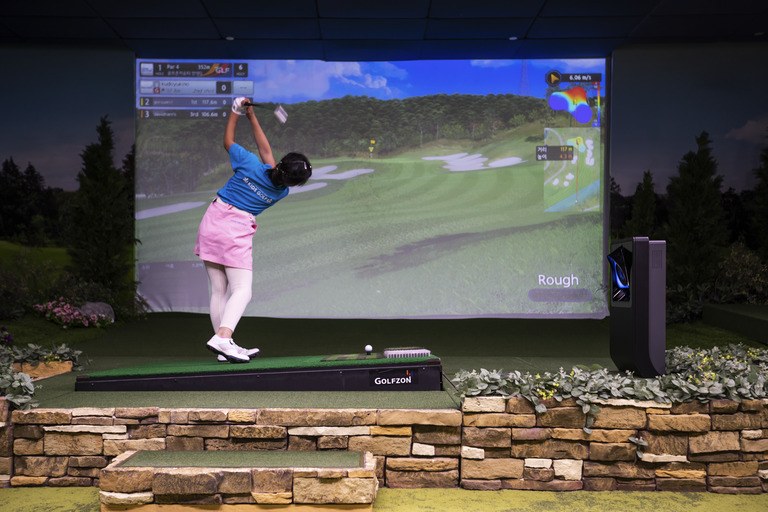The world’s biggest golfer doesn’t reside in Florida or California or Scotland, but in the tech-city of Daejeon, South Korea. Gleaming stainless steel and 69 feet tall, “The Golfer” by artists Ji Yong Ho and Park Dae Gyu has androgynous curves through the hips and chest and is a monument to a player of the future, not the past. Reflecting the noon sun with nearly as much pop is the swooping seven-story structure adjacent, the company headquarters of Golfzon. (English speakers: Mentally tack on an “e” for the correct pronunciation.) Founded by a former Samsung executive, the company operates courses and retail shops, but the most important part of its business is its simulators, which last year totaled 56 million rounds across 46 countries, as well as Antarctica. Maybe you’ve taken indoor swings in a clubfitting studio or a wealthy buddy’s basement, but prepare to encounter something else entirely at the top of this building’s first escalator. When you come back outside, you’ll wonder if it really was a simulation, or the emergence of a new sport altogether.
• • •
Screen golf versus field golf
South Koreans differentiate between “screen golf” and “field golf” with no sense of irony. Recently, the republic became the only country where more rounds are played annually on the former than the latter. Golfzon locations (5,756) outnumber Starbucks by 5-to-1. New-course construction has halted, so for a golf-passionate nation where few children grow up with yards, screen golf has provided a rising middle-class with a sense of recreational green space. An hour of play, which is more than enough time for a single golfer to complete 18 holes, generally starts around $25 with small upcharges for better courses.

Greg Samborski
Ten-year-old Kudo Yukino of Japan is successful competing against men in screen golf.
Screen baseball is also popular, as is screen fishing. Yes, you cast a line-less rod, and a projection of a hook and sinker penetrates the surface of an idyllic digital lake. Just the right amount of auditory hints, like lapping water and birdsong, sift through speakers. Algorithms decide when and if a fish will bite and how big, and gyroscopes inside the pole shudder to provide a sensation of fight. Your forearms will burn as you work the reel, and without proper finesse, you might lose the fish. Outdoorsmen from Montana can spit out their coffee and stammer—Is nothing sacred anymore?—but practices like catch-and-release aren’t without attendant philosophical questions, too. When it comes to what humans do for fun, let’s agree we’re all a little nutty sometimes.
RELATED: This is a simulation—and it’s still golf
So although a traditional golf tournament—you know, like, on a course with 18 physical holes—has a limit of about 150 players per day, screen golf knows no such restraint. Golfzon conducts up to 350 tournaments daily with top qualifiers regularly earning the chance to compete in weekend events at the headquarters store, which, along with its supporting restaurants and retail shops, is also known as Zoimaru (Joy-mah-roo). There, 27 simulator bays occupy three floors for a playing capacity of 108 players. When GTour is in session, panels on certain bays are removed to create stadium seating for spectators.
Screen-golf tournaments that are part of the GTour series are broadcast on TV and offered a season purse of $1.3 million in 2018.
What, you haven’t heard of GTour? The 10-tournament series, broadcast on television by suited commentators, offered a season purse of $1.3 million in 2018. WGTour offers the same prize money, though it could be argued Korean women should earn more, given they’ve so far outscored their countrymen, 14-1, in regular major championships. (Inbee Park is the leader with seven, and the male singularity is Y.E. Yang besting Tiger Woods head-to-head at the 2009 PGA Championship.) Depending on schedule and status, some rising pros will split time between GTour and traditional “field” events on the Korean PGA Tour.

Courtesy of Golfzon
When GTour is in session, panels on bays are removed to create stadium seating for spectators.
Hong-taek Kim was struggling to revive his playing career after fulfilling his mandatory military service, but he got his confidence back by winning simulator tournaments. In 2017, he won on the GTour and the Korean PGA Tour. Though a strong finish in screen golf doesn’t award World Ranking points (yet), the checks cash just the same, and you don’t have to walk, employ a caddie or carry an umbrella. If this seems an inadequate physical test for a professional athlete, consider the growing popularity of e-gaming, where top competitors have earned millions from the repose of a chair. Screen golf’s preservation of the essential physical act is a hybrid model that future endeavors rooted in artificial reality—or augmented reality—would do well to follow.
• • •
What it’s like to play
Of course, a land where screen golf reigns is a distant fantasy until you see it in person. My visit to Zoimaru, on my way to the PGA Tour’s CJ Cup in Jeju Island that would be won by Brooks Koepka, coincided with the third edition of the International Golfzon Tournament. Qualifying at their local Golfzon locations, 18 amateurs from 11 countries won airfare and a spot in the field for a gold bar worth about $3,000. It’s a trophy, not a paycheck, so technically not a violation of amateur status. And the weight of the bar, 50 grams, is just shy of the limit of what may be transported through Customs by a civilian without hassle.
Though the standard for an indoor hitting bay is some sort of cube with a turf mat and dark drapes, at Zoimaru the line with reality is more blurred. When it’s your turn to hit, you ascend a few stone steps to a terraced tee box bordered with flowers. After your drive, the teeing area tilts to match the slope of the approach shot. The ceilings are high—airy even—and the potted trees are a continuation of the same variety depicted in the landscape of the wall murals flanking the screen. There’s piped audio of wind rustling leaves. If you soften your gaze and want to believe you’re playing golf in the Taebaek Mountains—not above the parking garage—you can.
RELATED: Do it Yourself: How to build your own simulator
The drawback of simulated golf has always been short game, and in particular, putting. From rolling balls directly into a screen, to a computer saving the leave distances of your approaches to determine a specific course to putt afterward on an indoor green, arriving at an actual score for a round has always felt disjointed and unsatisfying. Golfzon’s solution is a tilting upslope of green carpet directly in front of the tee. A perfectly struck putt might just get to the top of the slope before toppling off the edge; a putt with inadequate pace stops short and humiliatingly rolls back to your feet, inciting very real self-loathing. If you continue to struggle, there’s an instruction book, Screen Golf Master, with a long section devoted to this form of putting. Though I couldn’t find an English translation.

Courtesy of Golfzon
A winner’s check in simulated golf is worth about $13,400.
“It’s a constant battle for feel,” says Kyle Martin of South Africa. For the International Golfzon Tournament, with the click of a mouse, the greens have been sped to 14 on the Stimpmeter. As the round progresses, Martin works to tune his stroke to his mental calculation of what 14 means. In screen golf, he’s a scratch, and in the field he’s a 7-handicap. The 28-year-old market analyst has played only five rounds of “real golf” in the past two years. Besides the convenience, the simulated game suits his strength as a consistent ball-striker. “Alignment has always been an issue for me, but in here the mats help me be perfect every time,” Martin says. “There’s never a bad lie, and the wind you adjust for on the screen rather than it being something that messes with your swing.”
But screen golf isn’t just a power game, evidenced by Kudo Yukino, a 10-year-old girl whose mother is a franchise owner in Tokyo. She shot 81 to finish in the middle of the pack, not bad considering the simulation was all 7,100 yards of County Anseong Q, which is also a real course owned by Golfzon. Indonesia’s Euiro Lim was the champion with a one-under-par 71, though not without a little controversy. One competitor was psychologically derailed when he hit a beautiful approach to tap-in-birdie range, but then was forced to replay the shot after a spectator allegedly bumped the keyboard to trigger a mulligan. He flared his next out-of-bounds. After committee review, the player was awarded the original birdie instead of his subsequent double bogey, but for a spell it seemed the classic science-fiction horror where the computer won’t be overruled. Just as the USGA and R&A are still developing its Rules after more than a century, so, too, will screen golf continue to face such learning moments. The next day, American John Bouldin, a high school football and golf coach from Rosenberg, Texas, was medalist in the field-golf portion with a 78 on the actual County Anseong Q.
If you believe the world is inexorably hurtling toward a single, global culture, you can glimpse the golf club of the future by sneaking onto the other floors of Zoimaru.
The sale of simulators to private individuals is a healthy business in the Western world, but so far Golfzon has 17 public locations in the United States after opening offices here in 2017, and the next two are scheduled to open in Brooklyn, N.Y., and Stamford, Conn., this spring. The 12,000-square-foot Stamford facility will introduce “a light version” of the interconnected tournament capability that is so popular in Korea, says Tommy Lim, CEO of Golfzon America. Though the success of Topgolf and the entrance of newcomers like Drive Shack demonstrate the demand for driving ranges that deliver modern technology mixed with entertainment, these are quite “American” venues in that they’re outdoors, take up a lot of space, and can get as boisterous and alcohol-fueled as nightclubs. More in keeping with Korean culture, and perhaps the original spirit of the game, Golfzon bays provide private enclosures for intimate groups who are more likely to enjoy gourmet coffee while playing. An average location with six or seven simulators might see 10,000 visitors a year. Whether the Golfzon way gains traction in the United States remains to be seen.
But if you believe the world is inexorably hurtling toward a single, global culture, you can glimpse the golf club of the future by sneaking onto the other floors at Zoimaru. The gym occupies an entire level, the member’s lounge another, and the top floors are strictly for the elite academy. Nearly every day, 60 promising juniors, including those on the national team, come to train on simulators, monitor their strength and flexibility with every modern diagnostic device imaginable, and take classes in academic disciplines related to sport. Their coach, Si woo Sung, summarizes his philosophy: “Indoors, we focus on the swing, and when we go outdoors, we focus on the ball.”
Might Korea’s next great champion be a boy or girl who first fell in love with the game on a simulator? When you go onto the roof at Zoimaru, you can see the top of the sculpture at the top of its backswing. The massive steel club wavers ever so slightly in the wind, like it’s about to start down.
Introducing Golf Digest All Access, a new way to improve

